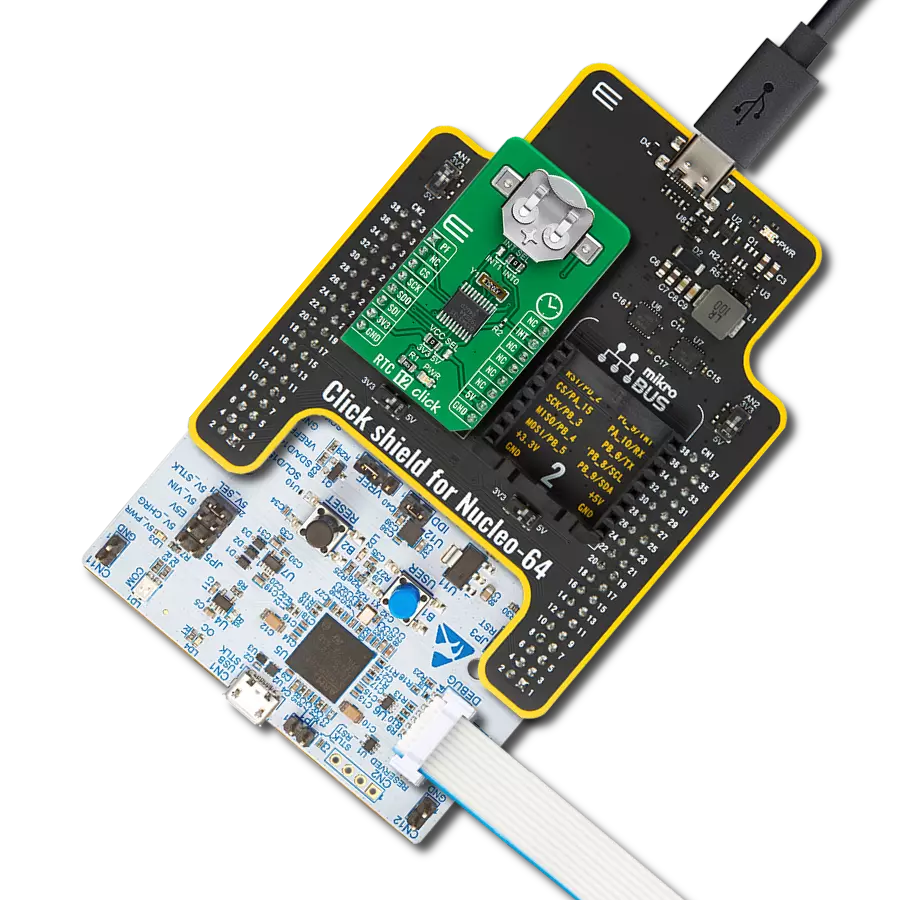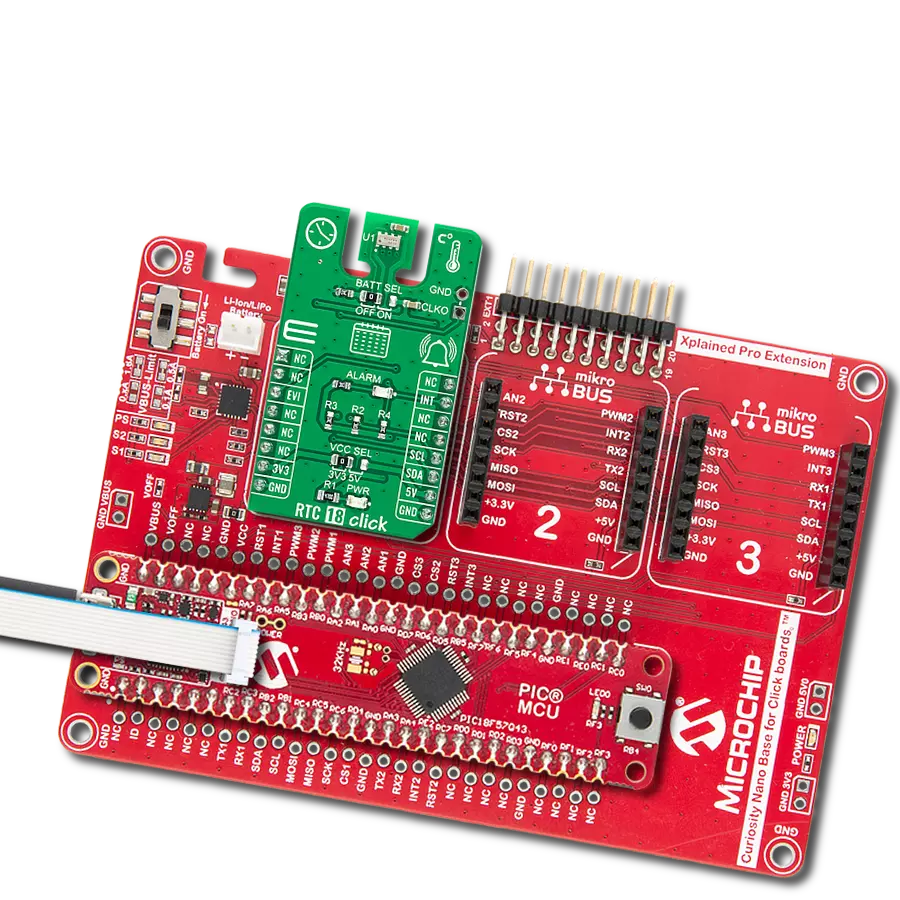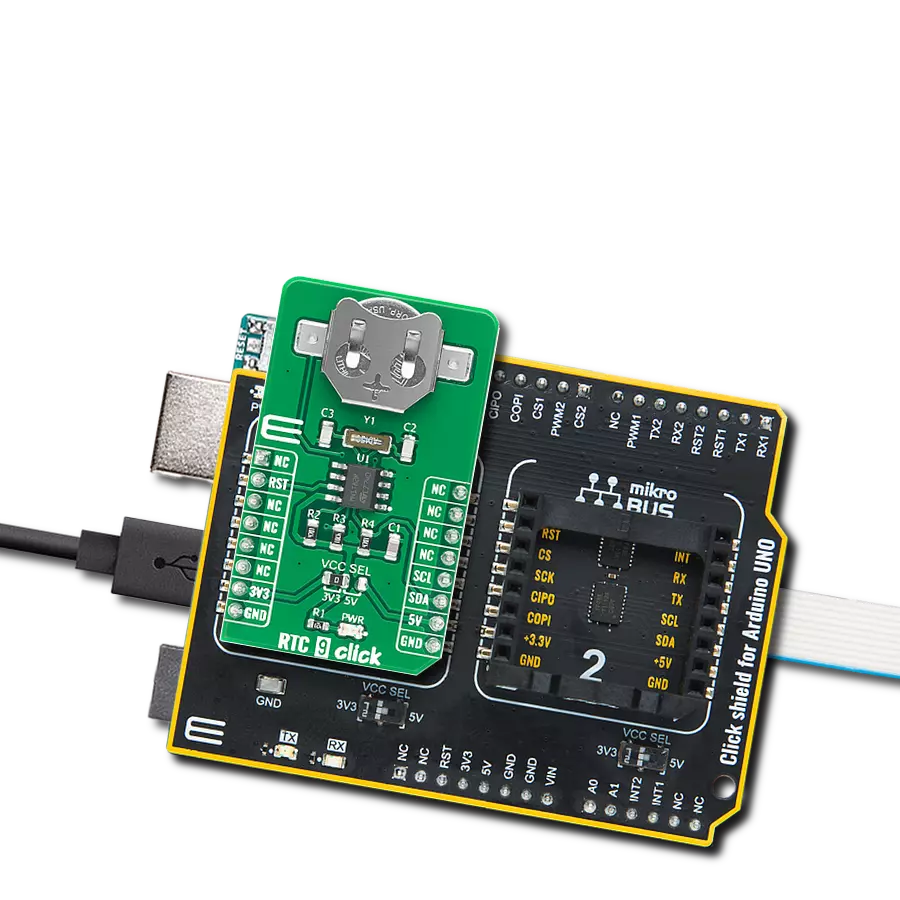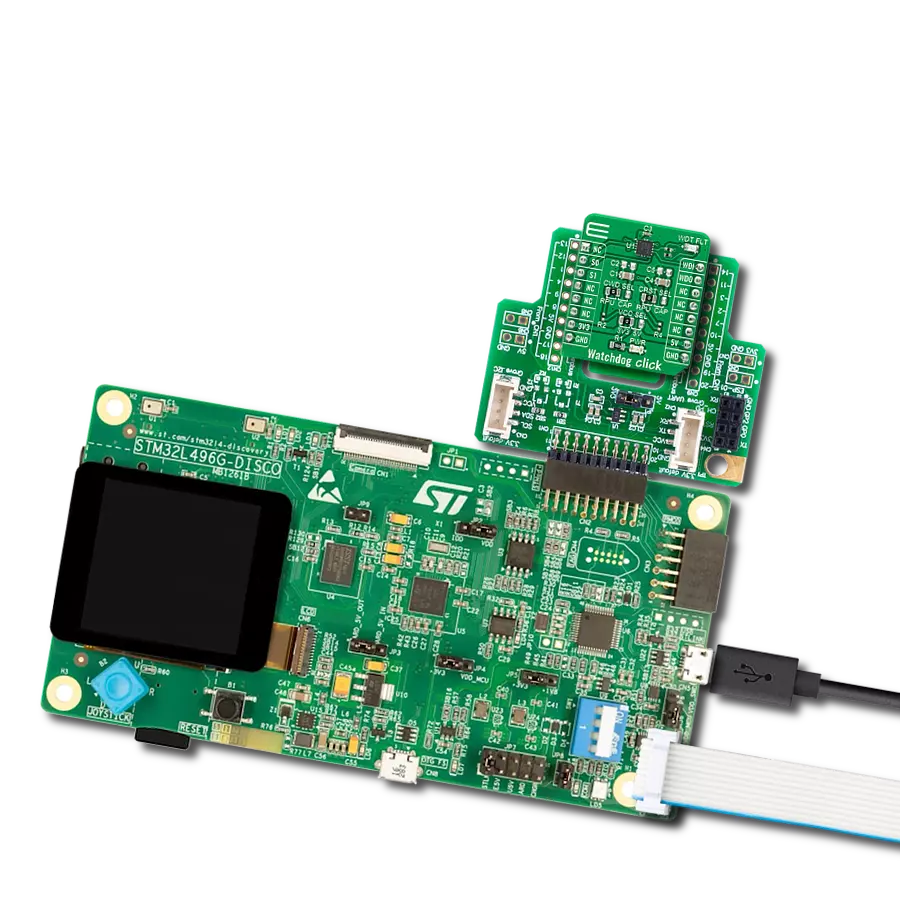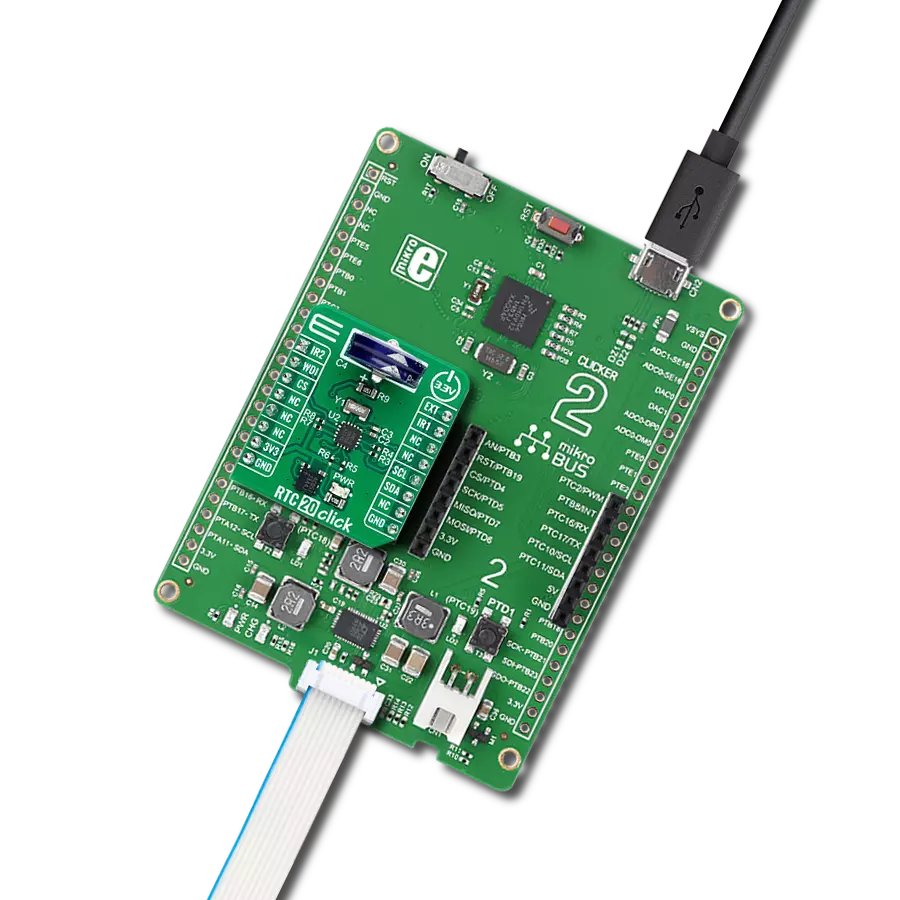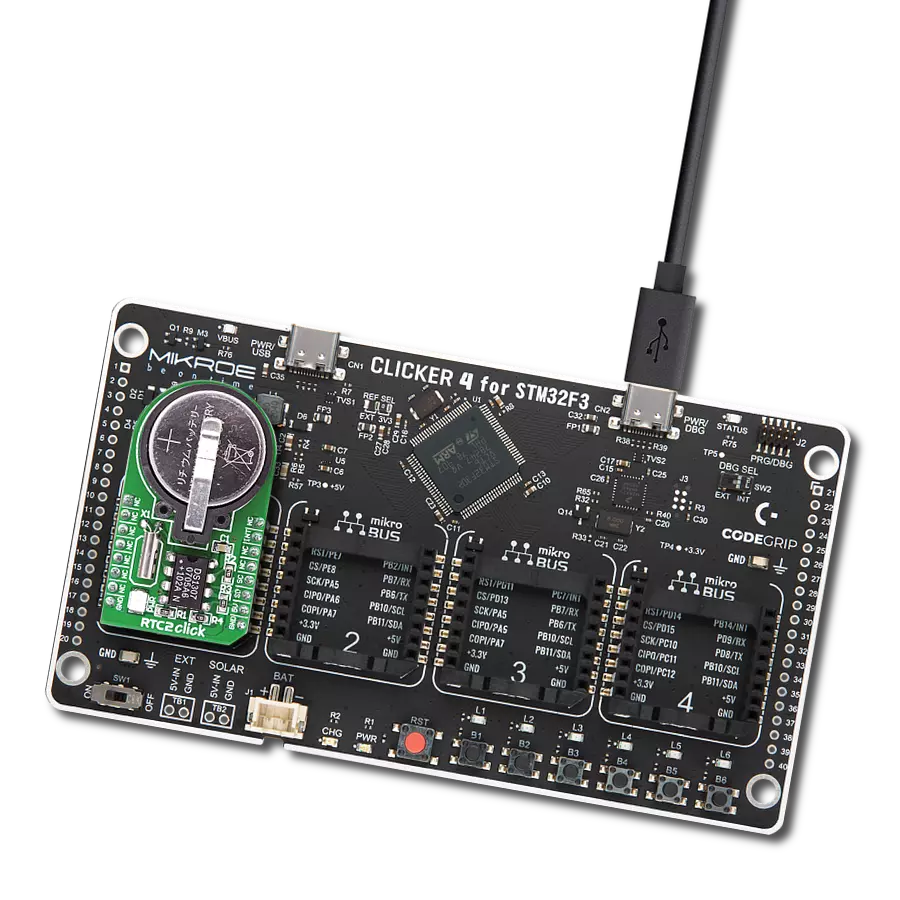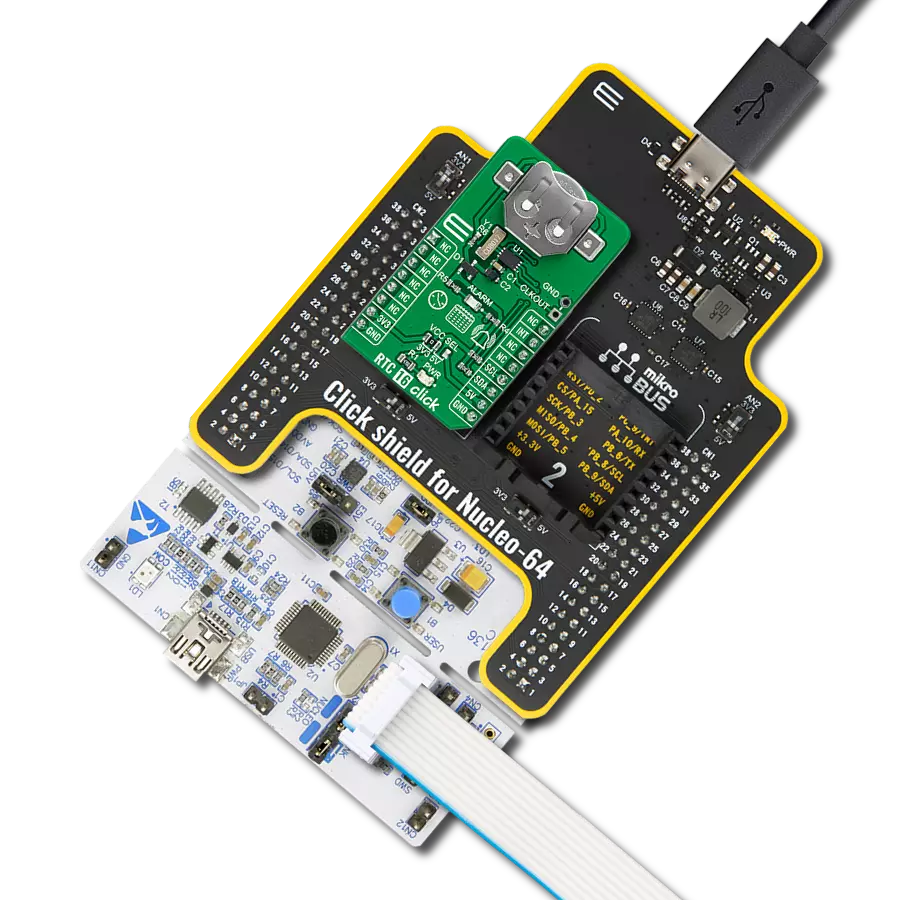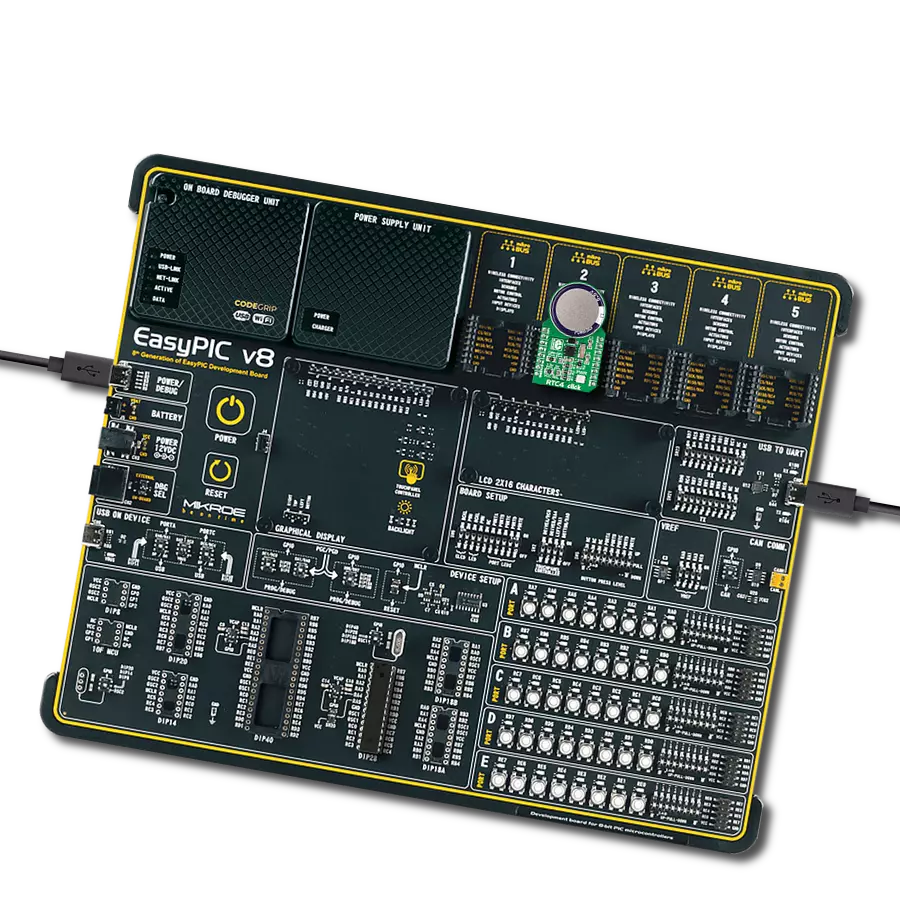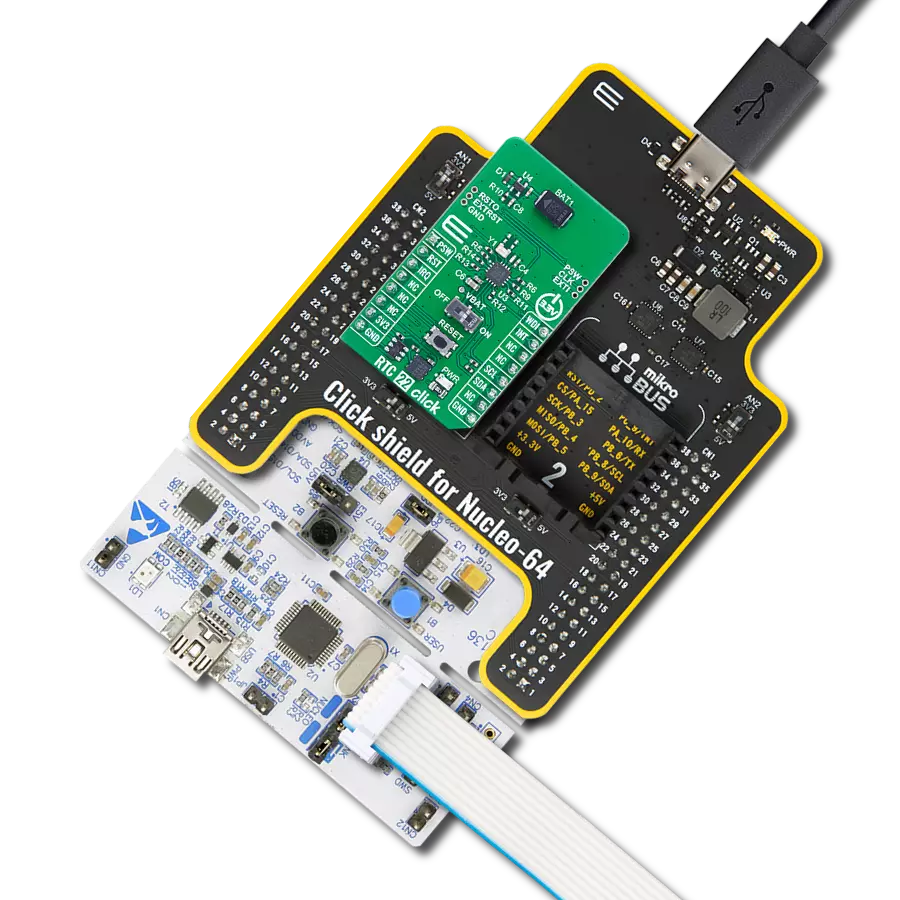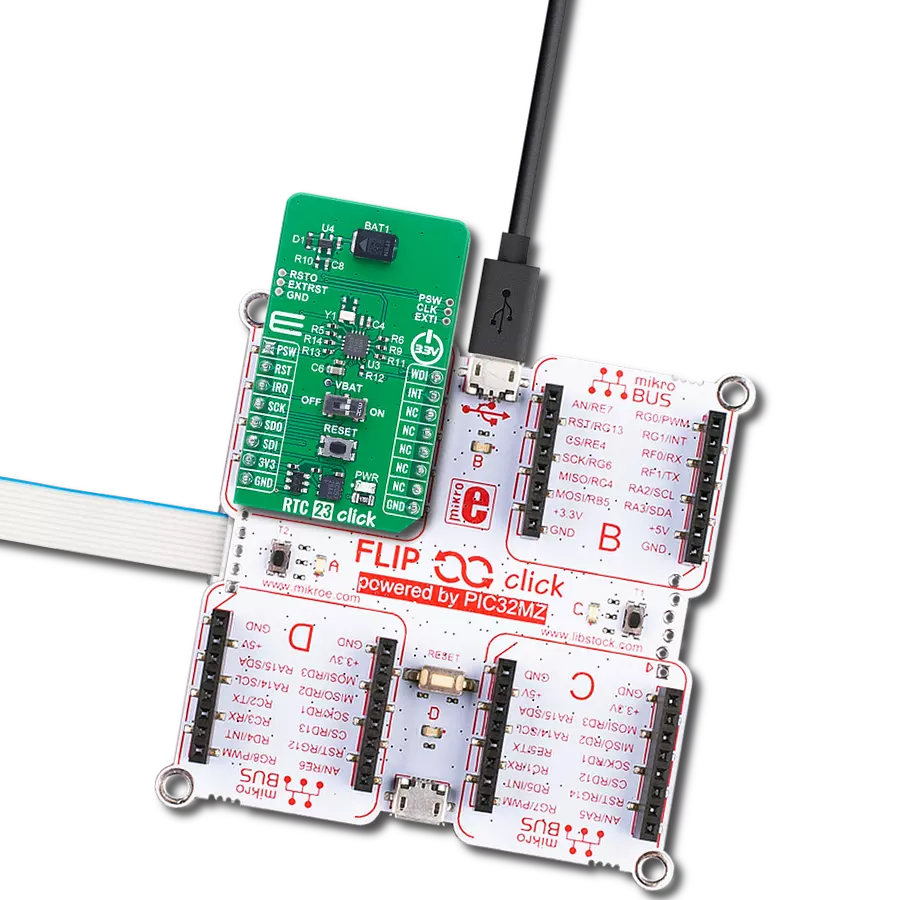Achieve seamless coordination and synchronization of events in your applications with our cutting-edge real-time clock solution
A
A
Hardware Overview
How does it work?
RTC 8 Click is based on the RV-3028-C7, an extreme low power real-time clock/calendar (RTC) module from Micro Crystal Switzerland. Thanks to its high integration level, this module provides high time accuracy, factory calibrated to 1 ppm, with a very low count of external components required. It has a full RTC function, offering programmable counters, alarms, and an interrupt engine with selectable event reporting sources. In addition to a standard clock output function, it also offers a 32-bit UNIX Time counter. The operational parameters are stored within the internal non-volatile memory (EEPROM) allowing their persistence in the event of the complete power failure. The small dimension of the RV-3028-C7 module itself, allow it to be used in very space-constrained applications, including wearables, medical equipment, and similar. In addition to the RV-3028-C7, RTC 8 click is equipped with the button cell battery holder compatible with the CR1225 battery. By utilizing an automatic backup switch, the IC is able to use an external battery power source when there is no power supply on its main power terminals, thus
allowing for uninterrupted operation. Draining as low as 40nA of current, it can be operated with the standard button cell battery almost indefinitely. In addition, a trickle charge system will replenish the battery power while the RV-3028-C7 is powered over the main power terminals (VDD, VSS). The voltage of the main power supply can range between 1.2V up to 5.5V. The RV-3028-C7 uses the I2C communication protocol for the communication with the host MCU. Besides the I2C bus lines, two additional pins are also available on the RV-3028-C7, allowing an interrupt to be reported to the host MCU, but also to capture an external event and marking it with an automatic timestamp. The user is able to set up standard clock and calendar functions (including seconds, minutes, hours, weekdays, date, months, years with leap year correction), as well as the interrupt functions for the periodic countdown timer, periodic time update, alarm, external event, automatic backup switchover and power on reset (POR) events. All these features are available when the module is operated over the backup power supply (battery). A group of configuration registers
is used to set up all the various working parameters of the device. To additionally prevent any unintentional changes of the internal registers, the RV-3028-C7 offers password protection of its configuration. If the password protection is set by an enable register in the non-volatile memory, each time the register configuration is attempted, the user will be required to enter the password first. Naturally, reading out the password registers will return 0 values; this register is write-only. Besides other functions, EEPROM memory holds the offset correction values. Offset correction is required for fine-tuning the internal 32.768 kHz XTAL, as well as for compensating the aging phenomenon. This Click board™ can operate with either 3.3V or 5V logic voltage levels selected via the VCC SEL jumper. This way, both 3.3V and 5V capable MCUs can use the communication lines properly. Also, this Click board™ comes equipped with a library containing easy-to-use functions and an example code that can be used as a reference for further development.
Features overview
Development board
PIC18F57Q43 Curiosity Nano evaluation kit is a cutting-edge hardware platform designed to evaluate microcontrollers within the PIC18-Q43 family. Central to its design is the inclusion of the powerful PIC18F57Q43 microcontroller (MCU), offering advanced functionalities and robust performance. Key features of this evaluation kit include a yellow user LED and a responsive
mechanical user switch, providing seamless interaction and testing. The provision for a 32.768kHz crystal footprint ensures precision timing capabilities. With an onboard debugger boasting a green power and status LED, programming and debugging become intuitive and efficient. Further enhancing its utility is the Virtual serial port (CDC) and a debug GPIO channel (DGI
GPIO), offering extensive connectivity options. Powered via USB, this kit boasts an adjustable target voltage feature facilitated by the MIC5353 LDO regulator, ensuring stable operation with an output voltage ranging from 1.8V to 5.1V, with a maximum output current of 500mA, subject to ambient temperature and voltage constraints.
Microcontroller Overview
MCU Card / MCU

Architecture
PIC
MCU Memory (KB)
128
Silicon Vendor
Microchip
Pin count
48
RAM (Bytes)
8196
You complete me!
Accessories
Curiosity Nano Base for Click boards is a versatile hardware extension platform created to streamline the integration between Curiosity Nano kits and extension boards, tailored explicitly for the mikroBUS™-standardized Click boards and Xplained Pro extension boards. This innovative base board (shield) offers seamless connectivity and expansion possibilities, simplifying experimentation and development. Key features include USB power compatibility from the Curiosity Nano kit, alongside an alternative external power input option for enhanced flexibility. The onboard Li-Ion/LiPo charger and management circuit ensure smooth operation for battery-powered applications, simplifying usage and management. Moreover, the base incorporates a fixed 3.3V PSU dedicated to target and mikroBUS™ power rails, alongside a fixed 5.0V boost converter catering to 5V power rails of mikroBUS™ sockets, providing stable power delivery for various connected devices.
Used MCU Pins
mikroBUS™ mapper
Take a closer look
Click board™ Schematic

Step by step
Project assembly
Software Support
Library Description
This library contains API for RTC 8 Click driver.
Key functions:
rtc8_set_time- Set new time - 24 hour formatrtc8_set_date- Set new datertc8_get_time_and_date- Get RTC data ( Time and Data )
Open Source
Code example
The complete application code and a ready-to-use project are available through the NECTO Studio Package Manager for direct installation in the NECTO Studio. The application code can also be found on the MIKROE GitHub account.
/*!
* \file
* \brief Rtc8 Click example
*
* # Description
* Demo application shows the operation of RTC 8 Clicks.
*
* The demo application is composed of two sections :
*
* ## Application Init
* Configuring Clicks and log objects.
* Settings the Click in the default configuration.
* Sets new: Time, Date, UNIX time and alarm data.
*
* ## Application Task
* Read current Time, Date and UNIX time and checks if the alarm is active.
*
* @note
* Comment out the lines for setting date and time if you would like the
* module to keep counting time after a reset or shut down.
*
* \author MikroE Team
*
*/
// ------------------------------------------------------------------- INCLUDES
#include "board.h"
#include "log.h"
#include "rtc8.h"
// ------------------------------------------------------------------ VARIABLES
static rtc8_t rtc8;
static log_t logger;
static rtc8_time_t time_s;
static rtc8_date_t date_s;
static rtc8_alarm_t alarm_s;
// ------------------------------------------------------- ADDITIONAL FUNCTIONS
void display_weekday ( uint8_t weekday )
{
switch ( weekday )
{
case 0:
{
log_printf( &logger, " Monday \r\n" );
break;
}
case 1:
{
log_printf( &logger, " Tuesday \r\n" );
break;
}
case 2:
{
log_printf( &logger, " Wednesday \r\n" );
break;
}
case 3:
{
log_printf( &logger, " Thursday \r\n" );
break;
}
case 4:
{
log_printf( &logger, " Friday \r\n" );
break;
}
case 5:
{
log_printf( &logger, " Saturday \r\n" );
break;
}
case 6:
{
log_printf( &logger, " Sunday \r\n" );
break;
}
}
}
// ------------------------------------------------------ APPLICATION FUNCTIONS
void application_init ( void )
{
log_cfg_t log_cfg;
rtc8_cfg_t rtc8_cfg;
/**
* Logger initialization.
* Default baud rate: 115200
* Default log level: LOG_LEVEL_DEBUG
* @note If USB_UART_RX and USB_UART_TX
* are defined as HAL_PIN_NC, you will
* need to define them manually for log to work.
* See @b LOG_MAP_USB_UART macro definition for detailed explanation.
*/
LOG_MAP_USB_UART( log_cfg );
log_init( &logger, &log_cfg );
log_info( &logger, " Application Init " );
// Click initialization.
rtc8_cfg_setup( &rtc8_cfg );
RTC8_MAP_MIKROBUS( rtc8_cfg, MIKROBUS_1 );
if ( I2C_MASTER_ERROR == rtc8_init( &rtc8, &rtc8_cfg ) )
{
log_error( &logger, " Communication init." );
for ( ; ; );
}
if ( RTC8_ERROR == rtc8_default_cfg ( &rtc8 ) )
{
log_error( &logger, " Default configuration." );
for ( ; ; );
}
// 24h format - HH,MM,SS
time_s.hours = 23;
time_s.minutes = 59;
time_s.seconds = 50;
rtc8_set_time( &rtc8, &time_s );
// Set date format
date_s.weekdays = 5;
date_s.day = 31;
date_s.month = 12;
date_s.year = 22;
rtc8_set_date( &rtc8, &date_s );
// Set UNIX time
rtc8_set_unix_time( &rtc8, 1672527590ul );
// Set alarm format
alarm_s.weekdays = 6;
alarm_s.hours = 0;
alarm_s.minutes = 0;
rtc8_set_alarm( &rtc8, &alarm_s );
log_info( &logger, " Application Task " );
}
void application_task ( void )
{
static uint8_t time_seconds = 0xFF;
uint8_t alarm = 0;
uint32_t unix_time = 0;
err_t error_flag = rtx8_get_time_and_date( &rtc8, &time_s, &date_s );
error_flag |= rtc8_get_uinx_time( &rtc8, &unix_time );
error_flag |= rtc8_get_alarm_flag( &rtc8, &alarm );
if ( ( RTC8_OK == error_flag ) && ( time_seconds != time_s.seconds ) )
{
display_weekday ( date_s.weekdays );
log_printf( &logger, " Time: %.2u:%.2u:%.2u\r\n Date: %.2u.%.2u.20%.2u.\r\n",
( uint16_t ) time_s.hours, ( uint16_t ) time_s.minutes,
( uint16_t ) time_s.seconds, ( uint16_t ) date_s.day,
( uint16_t ) date_s.month, ( uint16_t ) date_s.year );
log_printf( &logger, " UNIX: %lu\r\n", unix_time );
if ( RTC8_ALARM_IS_ACTIVE == alarm )
{
log_info( &logger, " Alarm Activated!!! " );
rtc8_reset_alarm_flag( &rtc8 );
}
log_printf( &logger, "------------------\r\n" );
time_seconds = time_s.seconds;
}
Delay_ms ( 200 );
}
int main ( void )
{
/* Do not remove this line or clock might not be set correctly. */
#ifdef PREINIT_SUPPORTED
preinit();
#endif
application_init( );
for ( ; ; )
{
application_task( );
}
return 0;
}
// ------------------------------------------------------------------------ END
Additional Support
Resources
Category:RTC




















